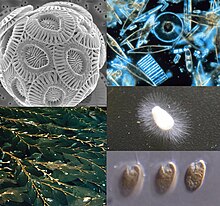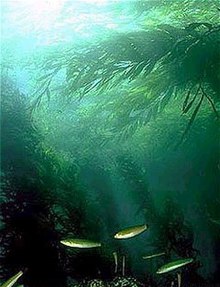Chromalveolata
| Chromalveolata | |
|---|---|

| |
| Clockwise from top-left: a phaeophyte
| |
| Scientific classification | |
| Domain: | Eukaryota |
| (unranked): | Bikonta |
| (unranked): | Chromalveolata Adl et al., 2005 (not a |
| Phyla | |
| |
Chromalveolata was a
.However, the monophyly of the Chromalveolata has been rejected. Thus, two papers published in 2008 have phylogenetic trees in which the chromalveolates are split up,[5][6] and recent studies continue to support this view.[7][8]
Groups and classification

Historically, many chromalveolates were considered
In 2005, in a classification reflecting the consensus at the time, the Chromalveolata were regarded as one of the six major clades of eukaryotes.[3] Although not given a formal taxonomic status in this classification, elsewhere the group had been treated as a Kingdom.[citation needed] The Chromalveolata were divided into four major subgroups:
- Cryptophyta
- Haptophyta
- Stramenopiles(or Heterokontophyta)
- Alveolata
Other groups that may be included within, or related to, chromalveolates, are:
Though several groups, such as the
However, as early as 2005, doubts were being expressed as to whether Chromalveolata was monophyletic,[9] and a review in 2006 noted the lack of evidence for several of the supposed six major eukaryote groups, including the Chromalveolata.[12] In 2012, consensus emerged that the group is not monophyletic. The four original subgroups fall into at least two categories: one comprises the Stramenopiles and the Alveolata, to which the Rhizaria are now usually added to form the SAR group; the other comprises the Cryptophyta and the Haptophyta.[5][6] A 2010 paper splits the Cryptophyta and Haptophyta; the former are a sister group to the SAR group, the latter cluster with the Archaeplastida (plants in the broad sense). The katablepharids are closely related to the cryptophytes and the telonemids and centrohelids may be related to the haptophytes.[7]
A variety of names have been used for different combinations of the groups formerly thought to make up the Chromalveolata.
- Halvaria Analyses in 2007 and 2008 agreed that the Stramenopiles and the Alveolata were related, forming a reduced chromalveolate clade, called Halvaria.[5][6][13]
- SAR group The Rhizaria, which were originally not considered to be chromalveolates, belong with the Stramenopiles and Alveolata in many analyses, forming the SAR group, i.e. Halvaria plus Rhizaria.[13][14]
- Hacrobia The other two groups originally included in Chromalveolata, the Haptophyta and the Cryptophyta, were related in some analyses,
Morphology
Chromalveolates, unlike other groups with multicellular representatives, do not have very many common morphological characteristics. Each major subgroup has certain unique features, including the alveoli of the Alveolata, the haptonema of the Haptophyta, the ejectisome of the Cryptophyta, and the two different flagella of the Heterokontophyta. However, none of these features are present in all of the groups.
The only common chromalveolate features are these:
- The shared origin of chloroplasts, as mentioned above
- Presence of cellulose in most cell walls
Since this is such a diverse group, it is difficult to summarize shared chromalveolate characteristics.
Ecological role

Many chromalveolates affect our ecosystem in enormous ways.
Some of these organisms can be very harmful.
However, many others are vital members of our ecosystem. Diatoms are one of the major photosynthetic producers, and as such produce much of the oxygen that we breathe, and also take in much of the carbon dioxide from the atmosphere. Brown algae, most specifically kelps, create underwater "forest" habitats for many marine creatures, and provide a large portion of the diet of coastal communities.
Chromalveolates also provide many products that we use. The
Chromalveolata viruses
Like other organisms, chromalveolata have viruses. In the case of Emiliania huxleyi (a common algal bloom chromalveolate), a virus believed to be specific to it causes mass death and the end of the bloom.[15]
See also
References
- Wikidata Q28254627.
- PMID 26234272.
- ^ S2CID 8060916.
- S2CID 34259721.
- ^ PMID 18522922.
- ^ PMID 18612431.
- ^ PMID 22298847.
- PMID 26817772.
- ^ a b Harper, J. T., Waanders, E. & Keeling, P. J. 2005. On the monophyly of chromalveolates using a six-protein phylogeny of eukaryotes. Int. J. System. Evol. Microbiol., 55, 487-496. "Archived copy" (PDF). Archived from the original (PDF) on 2008-12-17. Retrieved 2010-04-26.
{{cite web}}: CS1 maint: archived copy as title (link) - PMID 16790418.
- PMID 19270733.
- Wikidata Q21090155.
- ^ PMID 17726520.
- PMID 19237557.
- ^ Madhusoodanan, Jyoti (August 24, 2014). "Viral demise of an algal bloom:Marine viruses may be key players in the death of massive algal blooms that emerge in the ocean, a study shows". TheScientist.
